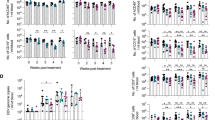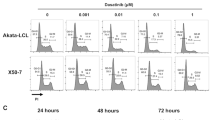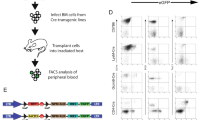Abstract
Genetic alterations in malignant tissues are potential targets for gene–based cancer therapies. Alternatively, aberrant expression of certain specific genes associated with malignant transformation may be envisioned to enhance the expression of chemosensitizing drugs. Epstein–Barr virus (EBV)–related B–cell lymphomas are fatal complications of immunosuppression due to AIDS, organ transplantation or congenital immune abnormalities. The malignant cells latently infected with EBV typically express the transcription factor EBNA2 as one of nine latent viral genes. We tested whether an EBNA2–responsive EBV promoter may selectively target EBV–related lymphoma cells by virus–regulated expression of a suicide gene. Using the BamC promoter driving a hygromycin–thymidine kinase fusion gene or controls, we demonstrated that sensitivity to ganciclovir was selectively enhanced in cells expressing EBNA2. Further, there was complete macroscopic regression of established B–cell lymphomas in mice with severe combined immunodeficiency disease (SCID mice) treated with a single course of ganciclovir. These data provide in vitro and in vivo support for a model of exploiting the molecular basis of tumor development to enhance the specificity of gene therapy.
This is a preview of subscription content, access via your institution
Access options
Subscribe to this journal
Receive 12 print issues and online access
$209.00 per year
only $17.42 per issue
Buy this article
- Purchase on Springer Link
- Instant access to full article PDF
Prices may be subject to local taxes which are calculated during checkout
Similar content being viewed by others
References
Rooney, C.M. et al. Host cell and EBNA-2 regulation of Epstein-Barr virus latent-cycle promoter activity in B lymphocytes. J. Virol. 66, 496–504 (1992).
Wang, F., Kikutani, H., Tsang, S. Kishimoto, T. & Kieff, E. Epstein-Barr virus nuclear protein 2 transactivates a cis-acting CD23 DNA element. J. Virol. 65, 4101–4106 (1991).
Ghosh, D. & Kieff, E. cis-Acting regulatory elements near the Epstein-Barr virus latent-infection membrane protein transcriptional start site. J. Virol. 64, 1855–1858 (1990).
Zimber-Strobl, U. et al. Epstein-Barr virus nuclear antigen 2 activates transcription of the terminal protein gene. J. Virol. 65, 415–423 (1991).
Grossman, S.R., Johannsen, E. Tong, X., Yalamanchili, R. & Kieff, E. The Epstein-Barr virus nuclear antigen 2 transactivator is directed to response elements by the Jκ recombination signal binding protein. Proc. Natl. Acad. Sci. USA 91, 7568–7572 (1994).
Henkel, T., Ling, P.D., Hayward, S.D. & Peterson, M.G. Mediation of Epstein-Barr virus EBNA2 transactivation by recombination signal-binding protein J kappa. Science 265, 92–95 (1994).
Calendar, A. et al. Epstein-Barr virus (EBV) induces expression of B-cell activation markers on in vitro infection of EBV-negative B-lymphoma cells. Proc. Natl. Acad. Sci. USA 84, 8060–8064 (1987).
Deisseroth, A.B., Kavanagh, J. & Champlin, R. Use of safety-modified retro-viruses to introduce chemotherapy during the therapy of ovarian cancer: A pilot trial. Hum. Gene Ther. 5, 1507–1522 (1994).
Dranoff, G. et al. Vaccination with irradiated tumor cells engineered to secrete murine granulocyte-macrophage colony-stimulating factor stimulates potent, specific, and long-lasting anti-tumor immunity. Proc. Natl. Acad. Sci. USA 90, 3539–3543 (1993).
Shewach, D.S. et al. Enhanced cytotoxicity of antiviral drugs mediated by adenovirus directed transfer of the herpes simplex virus thymidine kinase gene in rat glioma cells. Cancer Gem Ther. 1, 107–112 (1994).
Han, X., Kasahara, N. & Kan, Y.W. Ligand-directed retroviral targeting of human breast cancer cells. Proc. Natl. Acad. Sci. USA 92, 9747–9751 (1995).
Huber, B.E., Richards, C.A. & Krenitsky, T.A. Retroviral-mediated gene therapy for the treatment of hepatocellular carcinoma: An innovative approach for cancer therapy. Proc. Natl. Acad. Sci. USA 88, 8039–8043 (1991).
Vile, R.G. & Hart, I.R. In vitro and in vivo targeting of gene expression to melanoma cells. Cancer Res. 53, 962–967 (1993).
Rea, D. et al. Epstein-Barr virus latent and replicative gene expression in posttransplant lymphoproliferative disorders and AIDS-related non-Hodgkin's lymphomas. French Study Group of Pathology for HIV-associated Tumors. Ann. Oncol. 5 (Suppl. 1), S113–S116 (1994).
Knowles, D.M. Biologic aspects of AIDS-associated non-Hodgkin's lymphoma. Curr. Opin. Oncol. 5, 845–851 (1993).
Hamilton-Dutoit, S.J. et al Epstein-Barr virus-latent gene expression and tumor cell phenotype in acquired immunodeficiency syndrome-related non-Hodgkin's lymphoma: Correlation of lymphoma phenotype with three distinct patterns of viral latency. Am. J. Pathol. 143, 1072–1085 (1993).
Bashir, R., Luka, J., Cheloha, K., Chamberlain, M. & Hochberg, F. Expression of Epstein-Barr virus proteins in primary CNS lymphoma in AIDS patients. Neurology 43, 2358–2362 (1993).
Carbone, A., Tirelli, U., Gloghini, A., Volpe, R. & Boiocchi, M. Human immunodeficiency virus-associated systemic lymphomas may be subdivided into two main groups according to Epstein-Barr viral latent gene expression. J. Clin. Oncol. 11, 1674–1681 (1993).
daCosta, T.L., Jen, J., He, T.C., Chen, T.A. & Kinzler, K.W. Converting cancer genes into killer genes. Proc. Natl. Acad. Sci. USA 93, 4192–4196 (1996).
Hasegawa, R., Emi, N. & Shimokata, K. Retroviral transfer of HSV1-TK gene into human lung cancer cell line. J. Mol. Med. 73, 107–112 (1995).
Culver, K.W. et al. In vivo gene transfer with retroviral vector-producer cells for treatment of experimental brain tumors. Science 256, 1550–1552 (1992).
Hurford, R.K., Dranoff, G., Mulligan, R.C. & Tepper, R.I. Gene therapy of metastatic cancer by in vivo retroviral gene targeting. Nature Genet. 10, 430–435 (1995).
Oshiro, E.M. et al Toxicity studies and distribution dynamics of retroviral vectors following intrathecal administration of retroviral vector-producer cells. Cancer Gene Ther. 2, 87–95 (1995).
Lupton, S.D., Brunton, L.L., Kalberg, V.A. & Overell, R.W. Dominant positive and negative selection using a hygromycin phosphotransferase-thymidine kinase fusion gene. Mol Cell. Biol. 11, 3374–3378 (1991).
Author information
Authors and Affiliations
Rights and permissions
About this article
Cite this article
Franken, M., Estabrooks, A., Cavacini, L. et al. Epstein–Barr virus–driven gene therapy for EBV–related lymphomas. Nat Med 2, 1379–1382 (1996). https://doi.org/10.1038/nm1296-1379
Received:
Accepted:
Issue Date:
DOI: https://doi.org/10.1038/nm1296-1379
This article is cited by
-
Virally targeted therapies for EBV-associated malignancies
Oncogene (2003)
-
The antiviral prophylaxis of post-transplant lymphoproliferative disorder
Springer Seminars in Immunopathology (1998)



